
Gordon is a suburb on the Upper North Shore of Sydney in the state of New South Wales, Australia 14 kilometres (9 mi) north-west of the Sydney Central Business District and is the administrative centre for the local government area of Ku-ring-gai Council. East Gordon is a locality within Gordon, and West Gordon is a locality within West Pymble.
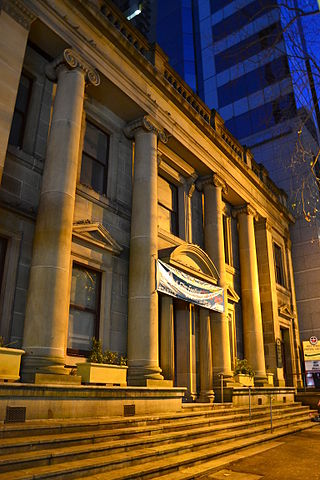
The Pitt Street Uniting Church is a heritage-listed Uniting church building located at 264 Pitt Street in the Sydney central business district, Australia. Founded in 1833, the congregation was the original church of Congregationalism in New South Wales. The church building was designed by John Bibb and built from 1841 to 1846. It is also known as Pitt Street Congregational Church. The property is owned by The Uniting Church in Australia and was added to the New South Wales State Heritage Register on 2 April 1999.

Deniliquin is a town in the Riverina region of New South Wales, Australia, close to the border with Victoria. It is the largest town in the Edward River Council local government area.

St Peter's Cathedral is an Anglican cathedral with heritage-listed building and grounds at 122 Rusden Street, Armidale, Armidale Regional Council, New South Wales, Australia. It is the mother church of the Anglican Diocese of Armidale. and the seat of the Anglican Bishop of Armidale. The cathedral was designed by John Horbury Hunt and Bishop James Francis Turner and built from 1871 to 1938. It is also known as the Anglican Cathedral Church of St Peter Apostle and Martyr. It was added to the New South Wales State Heritage Register on 12 March 2014.

St John's Anglican Church is a heritage-listed church at 153 Cunningham Street, Dalby, Western Downs Region, Queensland, Australia. It is the third church of that name on the site and was designed by Henry James (Harry) Marks and built in the 1920s. It is also known as St John's Church of England. It was added to the Queensland Heritage Register on 14 August 2008.
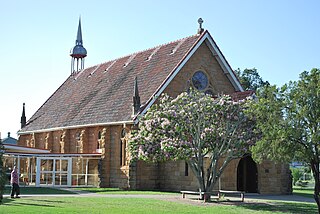
Warwick Uniting Church is a heritage-listed Uniting church at 37 Guy Street, Warwick, Southern Downs Region, Queensland, Australia. It was built from 1869 to 1922. It is also known as St Andrew's Presbyterian Church. It was added to the Queensland Heritage Register on 24 March 2000.

St Mary's Church is a heritage-listed Roman Catholic church precinct at Mary Street, Woodend, Ipswich, City of Ipswich, Queensland, Australia. It was built from 1874 to 1970s. It is also known as the former St Brigids Convent. It was added to the Queensland Heritage Register on 21 October 1992.
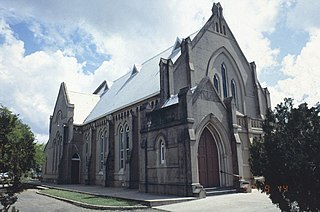
St Andrew's Presbyterian Church is a heritage-listed former Presbyterian church at 280 Bolsover Street, in the central business district of Rockhampton, Rockhampton Region, Queensland, Australia. The former church was designed by Voller & Graham in the Gothic Revival style and built from 1893 to 1926. The former church was added to the Queensland Heritage Register on 21 October 1992.

St Andrew's Anglican Church is a heritage-listed former Anglican church located at South Street, Walcha in the Walcha Shire, New South Wales, Australia. The site was added to the New South Wales State Heritage Register on 2 April 1999.

St John's Anglican Church, officially the Church of St John the Evangelist, is a heritage-listed Anglican church located at Darling Street, Wentworth, Wentworth Shire, New South Wales, Australia. It was designed by Reverend A. D. Soares and built in 1871. It is also known as St. John's Anglican Church and Rectory. The property is owned by the Anglican Parish of Wentworth. The church was added to the New South Wales State Heritage Register on 2 April 1999.
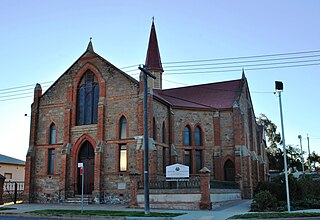
Wesley Uniting Church is a heritage-listed Uniting church at Cobalt Street, Broken Hill, City of Broken Hill, New South Wales, Australia. It was designed by Frederick William Dancker and built from 1885 to 1888 by Messrs. Walter and Morris. It is also known as Wesley Uniting Church and Hall Group, Wesleyan Uniting Church Group, Wesley Church and Wesley Hall. The property is owned by the Uniting Church in Australia. It was added to the New South Wales State Heritage Register on 23 April 2010 and on the Australian Register of the National Estate.

Old St Paul's Anglican Church is a heritage-listed former Anglican church at Cressy Street (South), Deniliquin, Edward River Council, New South Wales, Australia. The property is owned by the Edward River Council. It was added to the New South Wales State Heritage Register on 2 April 1999.

St Mary's Anglican Church is a heritage-listed Anglican church and associated facilities located at 240 Birrell Street, Waverley, in the Waverley Municipality, Sydney, New South Wales, Australia. The church was designed by Edmund Blacket and built between 1863 and 1864. It is very well known and sought after as a place to be married and is popular for funerals. The building is also notable due its pipe organ, designed and built by August Gern. The property is used for ministry by the Anglican Parish of Bondi and Waverley, which is an amalgamation of two previous Parishes ; The first Rector of St Mary’s Waverley, Rev Stanley Mitchell, was a keen Evangelical and although he used traditional Anglican liturgy was “low church” like most of Sydney Diocese. However there has been a long history of more “High” Anglicanism and Anglo Catholic theological underpinnings. Since 2014, the church has returned to a strongly evangelical base while running a very strong traditional 1662 prayer book communion service every Sunday. It also has less traditional al services to accommodate more contemporary congregations.

St Andrew's Presbyterian Church and Hall is a heritage-listed former church and now retail store at 67 Smith Street, Kempsey, Kempsey Shire, New South Wales, Australia. It was built from 1890. It was added to the New South Wales State Heritage Register on 2 April 1999.
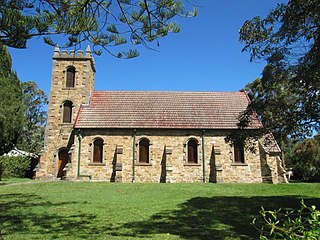
St Stephen's Presbyterian Church is a heritage-listed former Presbyterian church at 2 Allowrie Street, Jamberoo, Municipality of Kiama, New South Wales, Australia. It was designed by John Colley and built in 1875 by John and James Marks, D. L. Dymock and W. Stewart. It was added to the New South Wales State Heritage Register on 2 April 1999. The church building was sold to private interests in 2009.

St John's Uniting Church and Pipe Organ is a heritage-listed Uniting church at Yeo Street, Neutral Bay, North Sydney Council, New South Wales, Australia. The church was built by Tafield and Collins; and the pipe organ was built by Charles Richardson. It is also known as St. John's Uniting Church and Pipe Organ and Richardson Pipe Organ. The property is owned by the Uniting Church of Australia. It was added to the New South Wales State Heritage Register on 2 April 1999.

St John's Uniting Church is a heritage-listed Uniting church located at Coonanbarra Road in the Sydney suburb of Wahroonga in the Ku-ring-gai Council local government area of New South Wales, Australia. It was designed by John Shedden Adam and built from 1929 to 1930. It is also known as St. John's Uniting Church, Hall and Manse, Knox Church, Wahroonga Presbyterian Church, St John's Presbyterian Church, WPS and Wahroonga Preparatory School. The property is owned by the Uniting Church in Australia. It was added to the New South Wales State Heritage Register on 19 September 2003.
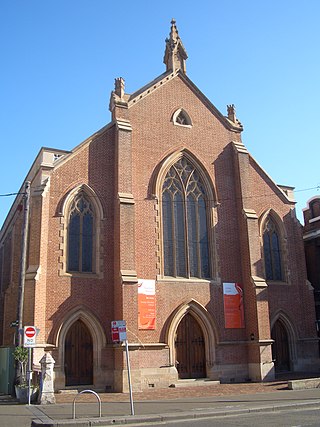
The Newtown Mission Uniting Church is a heritage-listed Uniting church at 280a King Street, Newtown, City of Sydney, New South Wales, Australia. It was designed by George Allen Mansfield and built in 1859 by Thomas Abbott. It was added to the New South Wales State Heritage Register on 2 April 1999.

Federation Hall is a heritage-listed former meeting hall and theatre and now commercial building that houses the Sydney Futures Exchange located at 24–30 Grosvenor Street in the inner city Sydney suburb of The Rocks in the City of Sydney local government area of New South Wales, Australia. It was built from 1889 to 1891, with alterations designed by Scott and Green. It is also known as Exchange Courtyard and Meat Board Building. The property is owned by Property NSW, an agency of the Government of New South Wales. It was added to the New South Wales State Heritage Register on 10 May 2002.

St Stephen's Uniting Church is a heritage-listed Uniting Church located at 197 Macquarie Street, in the Sydney central business district, in the City of Sydney local government area of New South Wales, Australia. Developed initially as St Stephen's Presbyterian Church, it was designed by Finlay Munro Jnr and John Reid and built from 1935 to 1937 by Kell & Rigby. It was added to the New South Wales State Heritage Register on 3 September 2004.





















